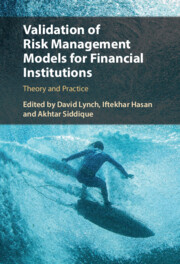Book contents
- Validation of Risk Management Models for Financial Institutions
- Validation of Risk Management Models for Financial Institutions
- Copyright page
- Contents
- Figures
- Tables
- Contributors
- Foreword
- Acknowledgments
- 1 Common Elements in Validation of Risk Models Used in Financial Institutions
- 2 Validating Bank Holding Companies’ Value-at-Risk Models for Market Risk
- 3 A Conditional Testing Approach for Value-at-Risk Model Performance Evaluation
- 4 Beyond Exceedance-Based Backtesting of Value-at-Risk Models: Methods for Backtesting the Entire Forecasting Distribution Using Probability Integral Transform
- 5 Evaluation of Value-at-Risk Models: An Empirical Likelihood Approach
- 6 Evaluating Banks’ Value-at-Risk Models during the COVID-19 Crisis
- 7 Performance Monitoring for Supervisory Stress-Testing Models
- 8 Counterparty Credit Risk
- 9 Validation of Retail Credit Risk Models
- 10 Issues in the Validation of Wholesale Credit Risk Models
- 11 Case Studies in Wholesale Risk Model Validation
- 12 Validation of Models Used by Banks to Estimate Their Allowance for Loan and Lease Losses
- 13 Operational Risk
- 14 Statistical Decisioning Tools for Model Risk Management
- 15 Validation of Risk Aggregation in Economic Capital Models
- 16 Model Validation of Interest Rate Risk (Banking Book) Models
- 17 Validation of Risk Management Models in Investment Management
- Index
- References
13 - Operational Risk
Published online by Cambridge University Press: 02 March 2023
- Validation of Risk Management Models for Financial Institutions
- Validation of Risk Management Models for Financial Institutions
- Copyright page
- Contents
- Figures
- Tables
- Contributors
- Foreword
- Acknowledgments
- 1 Common Elements in Validation of Risk Models Used in Financial Institutions
- 2 Validating Bank Holding Companies’ Value-at-Risk Models for Market Risk
- 3 A Conditional Testing Approach for Value-at-Risk Model Performance Evaluation
- 4 Beyond Exceedance-Based Backtesting of Value-at-Risk Models: Methods for Backtesting the Entire Forecasting Distribution Using Probability Integral Transform
- 5 Evaluation of Value-at-Risk Models: An Empirical Likelihood Approach
- 6 Evaluating Banks’ Value-at-Risk Models during the COVID-19 Crisis
- 7 Performance Monitoring for Supervisory Stress-Testing Models
- 8 Counterparty Credit Risk
- 9 Validation of Retail Credit Risk Models
- 10 Issues in the Validation of Wholesale Credit Risk Models
- 11 Case Studies in Wholesale Risk Model Validation
- 12 Validation of Models Used by Banks to Estimate Their Allowance for Loan and Lease Losses
- 13 Operational Risk
- 14 Statistical Decisioning Tools for Model Risk Management
- 15 Validation of Risk Aggregation in Economic Capital Models
- 16 Model Validation of Interest Rate Risk (Banking Book) Models
- 17 Validation of Risk Management Models in Investment Management
- Index
- References
Summary
This chapter provides an overview of operational risk modeling techniques used by industry participants and regulators in the USA, recommendations for how modeling techniques can be improved, and a summary of the model risk tools necessary for any operational risk modeling framework.
Keywords
- Type
- Chapter
- Information
- Validation of Risk Management Models for Financial InstitutionsTheory and Practice, pp. 331 - 358Publisher: Cambridge University PressPrint publication year: 2023



